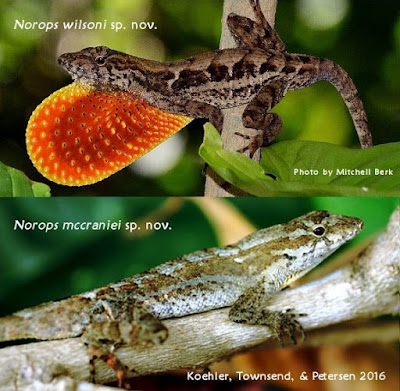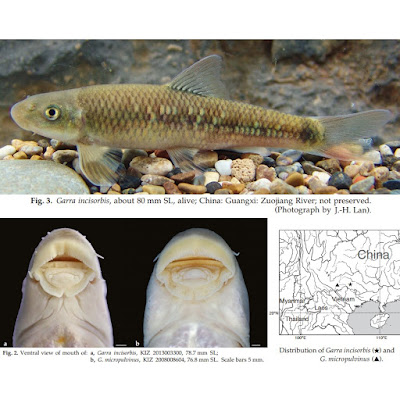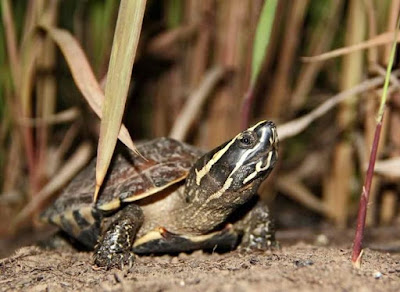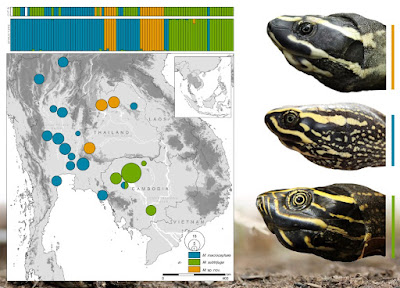[Most Recent Entries] [Calendar View]
Friday, April 8th, 2016
| Time | Event | ||||||||
| 1:22a | [Herpetology • 2016] A Taxonomic Revision of the Norops tropidonotus complex (Squamata, Dactyloidae), with the Resurrection of N. spilorhipis (Álvarez del Toro and Smith, 1956) and the Description of Two New Species; Norops wilsoni & N. mccraniei
Abstract We describe two new species of anoles from Honduras, which previously have been referred to as Norops tropidonotus by different authors: Norops mccraniei sp. nov. from the Chortís Highlands of Honduras, El Salvador, northern Nicaragua, and eastern Guatemala; and Norops wilsoni sp. nov. from the Atlantic slopes of the Cordillera Nombre de Dios (departments of Atlántida and Colón). Furthermore, we resurrect Anolis tropidonotus spilorhipis Álvarez del Toro and Smith, 1956 from synonymy with Norops tropidonotus. These four species are similar in external morphology, but differ by molecular distances, phylogenetic relationships, and in hemipenial morphology, as well as in subtle differences in several scalation and morphometric characters. Each of the six species in the N. tropidonotus complex exhibits a parapatric to allopatric distribution pattern. Key Words: Cryptic species, DNA barcoding, hemipenial morphology, Nuclear Central America, 16S Gunther Köhler, Josiah H. Townsend and Claus Bo P. Petersen. 2016. A Taxonomic Revision of the Norops tropidonotus complex (Squamata, Dactyloidae), with the Resurrection of N. spilorhipis (Álvarez del Toro and Smith, 1956) and the Description of Two New Species. Mesoamerican Herpetology 3: 8–41. Resumen: Se describen dos especies nuevas de anolis de Honduras, que anteriormente se han referido como Norops tropidonotus por diferentes autores: Norops mccraniei sp. nov. de las Chortís Highlands de Honduras, El Salvador, el norte de Nicaragua y el este de Guatemala; y Norops wilsoni sp. nov. de la vertiente Atlantica de la Cordillera Nombre de Dios (departamentos de Atlantida y Colón). Ademas, revalidamos Anolis tropidonotus spilorhipis Álvarez del Toro y Smith, 1956 de la sinonimía con Norops tropidonotus. Estas cuatro especies son similares en su morfología externa, pero difieren entre si por distancias moleculares, relaciones filogenéticas, en la morfología de los hemipenes, y además en diferencias sutiles en varios caracteres de escamación y morfometría. Cada una de las seis especies en el complejo de N. tropidonotus exhibe un patrón parapátrico a alopátrico de distribución. Palabras Claves: ADN, códigos de barras, especies crípticas, morfología del hemipene, Centroamérica Norte, 16S | ||||||||
| 2:31p | [Ichthyology • 2016] Garra incisorbis • A New Species of Labeonine (Teleostei: Cyprinidae) from Pearl River Basin in Guangxi, China
Garra incisorbis, new species, is described from the Pearl River drainage, Guangxi, China. It has a median notch on posterior edge of the oral sucking disc shared only with G. micropulvinus. Garra incisorbis is distinguished by having 2-4 fleshy buds on each side of the central fleshy pad, a fan-shaped central fleshy pad, prominent papillae densely set over the central pad, and 14 circumpeduncular scale rows. Distribution. Garra incisorbis is presently known only from the Sanchahe River, a small tributary of Zuojiang River, in Napo County, Guangxi Province, China, draining into the Pearl River (Fig. 4). Etymology. From the Latin incisus (notched) and orbis (circle, disk), an allusion to posterior edge of the oral sucking disc with a median notch. A noun in apposition. Lan-Ping Zheng, Jun-Xing Yang and Xiao-Yong Chen. 2016. Garra incisorbis, A New Species of Labeonine from Pearl River Basin in Guangxi, China (Teleostei: Cyprinidae). Ichthyol. Explor. Freshwaters. 26(4); 299-303 | ||||||||
| 2:40p | [Herpetology • 2016] Malayemys khoratensis | Khorat Snail-eating Turtle • Integrative Taxonomy of Southeast Asian Snail-Eating Turtles (Geoemydidae: Malayemys) Reveals A New Species and Mitochondrial Introgression
Abstract Based on an integrative taxonomic approach, we examine the differentiation of Southeast Asian snail-eating turtles using information from 1863 bp of mitochondrial DNA, 12 microsatellite loci, morphology and a correlative species distribution model. Our analyses reveal three genetically distinct groups with limited mitochondrial introgression in one group. All three groups exhibit distinct nuclear gene pools and distinct morphology. Two of these groups correspond to the previously recognized species Malayemys macrocephala (Chao Phraya Basin) and M. subtrijuga (Lower Mekong Basin). The third and genetically most divergent group from the Khorat Basin represents a previously unrecognized species, which is described herein. Although Malayemys are extensively traded and used for religious release, only few studied turtles appear to be translocated by humans. Historic fluctuations in potential distributions were assessed using species distribution models (SDMs). The Last Glacial Maximum (LGM) projection of the predictive SDMs suggests two distinct glacial distribution ranges, implying that the divergence of M. macrocephala and M. subtrijuga occurred in allopatry and was triggered by Pleistocene climate fluctuations. Only the projection derived from the global circulation model MIROC reveals a distinct third glacial distribution range for the newly discovered Malayemys species. Malayemys khoratensis sp. nov. urn:lsid:zoobank.org:act:B88DB370-C3D0-4 Holotype: THNHM 25816, young, adult female (Fig 6) from Udon Thani, Udon Thani Province, Thailand (17.36555°N, 102.81427°E, WGS 1984), collected in July 2014 by FI and MC.
Diagnosis: Malayemys species with a straight carapace length below 20 cm and a tricarinate, blackish-brown carapace, and a blackish-brown head with distinct yellowish facial stripes. Malayemys khoratensis differs from M. macrocephala by the following characters: (1) first vertebral scute roughly square and not tapered posteriorly (V1W/V1L: 0.83±0.09 vs. 0.74±0.19 in females, 0.83±0.12 vs. 0.69±0.09 in males); (2) lower marginal scutes 8–12 with a pattern of diagonal to cone-shaped blackish brown blotches originating from the outer posterior corner vs. narrow blackish-brown bars at the posterior sutures; (3) infraorbital stripe not or rarely reaching the loreal seam, not broadened at the suture vs. always reaching the loreal seam and usually distinctly broadened at the suture; (4) infraorbital stripes only slightly curved below anterior edge of eyes vs. distinctly curved or angled; (5) short yellowish postocular stripe (between supraorbital and infraorbital stripe) lacking or reduced vs. postocular stripe always present and distinct (Fig 7). Etymology: The species epithet refers to the Khorat Basin, the watershed to which the range of the new species appears to be restricted. The proposed English common name is Khorat Snail-eating Turtle.
Distribution: M. khoratensis is so far only known from the Khorat Basin of northeastern Thailand. More precisely from Sikhio District, Nakhon Ratchasima Province, a location drained by the Mun River, and the provinces of Udon Thani (type locality) and Nong Bua Lamphu, in areas associated with the Chi River, a tributary of the Mun River. Flora Ihlow, Melita Vamberger, Morris Flecks, Timo Hartmann, Michael Cota, Sunchai Makchai, Pratheep Meewattana, Jeffrey E. Dawson, Long Kheng, Dennis Rödder and Uwe Fritz. 2016. Integrative Taxonomy of Southeast Asian Snail-Eating Turtles (Geoemydidae: Malayemys) Reveals A New Species and Mitochondrial Introgression. PLoS ONE. DOI: 10.1371/journal.pone.0153108 New turtle discovered in Asia! http://www.idw-online.de/-CecmBA ResearchGate.net/publication/299800789_I ResearchGate.net/publication/299800256_D |
| << Previous Day |
2016/04/08 [Calendar] |
Next Day >> |







